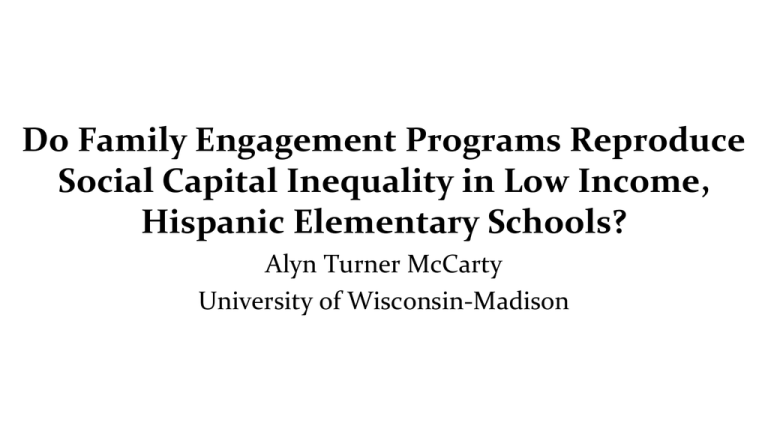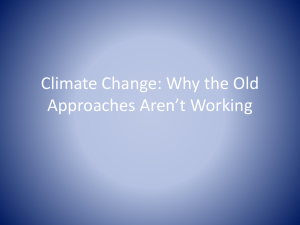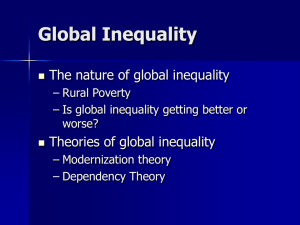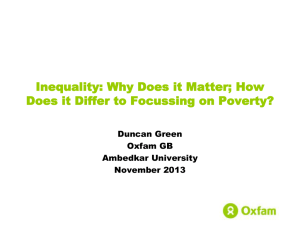to view Alyn`s presentation in power point
advertisement

Do Family Engagement Programs Reproduce Social Capital Inequality in Low Income, Hispanic Elementary Schools? Alyn Turner McCarty University of Wisconsin-Madison Overview • Examine how schools invest in parent social capital – Test effects of a randomized field experiment of an after-school program called Families and Schools Together – Observational versus experimental design • Focus on early social environments of children in high poverty, predominantly Hispanic communities Overview • Test for heterogeneity of program effects by prior social capital measured at two levels: family and school • Consider three possible impacts of the program on social capital inequality – Compensatory hypothesis – Cumulative advantage hypothesis – Maintained inequality hypothesis Overview • Preview of findings: – Results of experiment have contradictory implications for patterns of inequality • Intervention builds social capital more for families who are initially more socially isolated than for families who are initially more socially connected • Intervention effect on social capital is more pronounced in schools in which parent networks are initially stronger than in schools where parent networks are initially weaker Social Capital • Broadly defined, social capital refers to obligations and expectations, information, and norms, that inhere in social relations (Coleman, 1988). • Conceptualized as a property of social networks, which individuals can access by virtue of network membership Social Capital • Family-level social capital – Access to a network of other parents – Reflects the social connectivity and social resources in a child’s home environment – Parents can “invest” to promote their child’s development • School-level social capital – Property of parent networks – Represents the collective resources and normative environment of the school – Schools can “invest” to boost academic and behavioral outcomes of their student populations Social Capital • Potential benefits of social capital – Information flow, social control (Carbonaro 1999; Coleman 1990) – Collective efficacy (Cucchiara and Horvat 2009; Sampson et al 1997) – Social/emotional support and advice (Thoits 2011; Cohen 2004) • Psychological well-being Social Capital Inequality • Considerable amount of work has posited that social capital may be a key mechanism of the reproduction of inequality along familiar dimensions of stratification (Lin 2000) – By race/ethnicity (Stanton-Salazar 2001; Zhou and Bankston 1994) – By social class (Horvat, Weininger, and Lareau 2003; Lareau 1987) – And, more recently, by gender (McCarty and Shoji, in progress) Family Engagement Programs • Family engagement programs may be an important policy lever through which schools can promote strong parent networks • While family engagement programs are associated with positive outcomes on average, few studies have examined: – Effect of programs on social capital – Variation in the influence of programs Research Questions • Do family engagement programs promote social capital? • Does the effect vary in ways that may increase or decrease existing social capital inequality? Research Questions • H1: Family engagement programs reduce social capital inequality – “Compensatory hypothesis” • H2: Family engagement programs exacerbate social capital inequality – “Cumulative advantage hypothesis” • H3: Family engagement programs maintain social capital inequality – “Maintained inequality hypothesis” Intervention Approach • Explore variation in the effects of a popular family engagement program called Families and Schools Together • Treatment administered at the school-level, appropriate for research question about social capital within school communities • Random assignment of 26 schools to “treatment” and 26 schools to “control” Data Source • Children, Families, and Schools (CFS) Study – 52 low-income elementary schools – Phoenix, AZ and San Antonio, TX – 3,084 first graders and their families • Predominantly low-income, Hispanic population* FAST • Families and Schools Together (FAST) – Research-based after-school program • universally recruited 1st grade families • 8 weeks of weekly meetings at schools • 2 years of monthly meetings – Designed to strengthen bonds • parents and school staff • parents and other parents • parents and children Measures • Parent pre-FAST and post-FAST surveys – Parent responses to questions about the structure and quality of their social connections with other parents • How many parents of your child’s friends do you know? • To what extent do other parents share your expectations for your child? • Extent to which you and other parents reciprocate favors and social support? Measures • Family-level social capital – “Access to social capital” or “Social connectedness” – Composite of three dimensions, alpha = 0.72 – Standardized (mean = 0, std = 1) • School-level social capital – “School social capital” – Aggregated school-level measure – Standardized (mean = 0, std = 1) Research Question #1 Do family engagement programs promote social capital? FAST Effect on Social Capital FAST (γ01) Coefficient SE t-statistic 0.206 0.039 6.27 Note: Models control for study design effects and pre-treatment differences in social capital at family and school-levels. Research Question #2 Do effects vary in ways that may increase or decrease existing social capital inequality? Inequality in FAST Participation Coefficient SE t-statistic FAST 0.204 0.037 6.41 Pre-FAST SC Access 0.700 0.024 29.12 Interaction -0.069 0.032 -2.15 Pre-FAST SC Aggregate -0.018 0.022 0.368 Interaction 0.124 0.029 3.17 Predicted Access to Social Capital Predicted Access to Social Capital FAST Effect in SD Units 0.40 0.35 0.30 0.25 0.20 0.15 0.10 0.05 0.00 School: Low School: Medium School: High Family: Low 0.13 0.24 0.36 Family: Medium 0.06 0.18 0.30 Family: High 0.00 0.12 0.23 Proportion Graduated from FAST 0.40 0.35 0.31 0.30 0.25 0.20 0.19 0.2 Q1 Q2 0.26 0.26 Q3 Q4 0.15 0.10 0.05 0.00 Quintiles of Access to Social Capital Q5 Proportion Graduated from FAST 0.37 0.40 0.35 0.30 0.25 0.27 0.29 0.29 Q3 Q4 0.23 0.20 0.15 0.10 0.05 0.00 Q1 Q2 Quintiles of Access to Social Capital Q5 Summary of Findings • FAST increases social capital by strengthening parent-based social networks • While the effect is more pronounced for families who are initially less connected, • The effect is largest in schools with strong parent networks. Summary of Findings • Families are most likely to participate if they already have strong connections to other parents at the school • But, pre-existing connections only moderately predictive of participation. Discussion • Prior work emphasizes that disadvantaged communities lack social capital that can be used as a resource for parents and children. • But, what happens when schools provide opportunities to build social capital within these communities? Discussion • Programs that address the structural and cultural reasons why families do not usually participate in school-based activities have the potential to facilitate resourceful social ties with other parents with children at the school. Discussion • Although parents who are more socially connected are more likely to participate, families who are less socially connected benefit more from participation. • The better programs are at engaging families who would otherwise lack access to school-based parent network social capital, the more they can promote inclusion and equality in the distribution of community-based social resources. Discussion • Schools with pre-existing social capital may be best able to implement FAST because they are able to draw on the resources that are embedded in parent networks. • I show that building social capital equitably requires taking stock of existing resources, both among individuals and at the group level by examining the effects of a program by pre-existing levels of social capital among families and across schools. Thank you! This work is supported by dissertation grants from: • • • Robert Wood Johnson Foundation American Education Research Association UW-Madison Institute for Research on Poverty Acknowledge additional support from: • • Institute of Education Sciences (Grant No. R305C05005) NIH training grants: – – – UW-Madison Center for Demography and Ecology (Grant No. R24HD047873) Center for Demography of Health and Aging (Grant No. P30AG17266) Center for Women’s Health and Health Disparities Research (5T32HD049302-08) This research uses restricted use data from the Children, Families, and Schools study, a project designed by Adam Gamoran, Lynn McDonald Ruth Lopez Turley, and Carmen Valdez and funded the National Institute for Child Health and Human Development (Grant No. 1R01HD051762-01A2).







